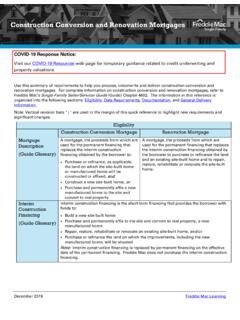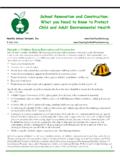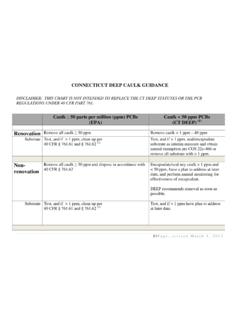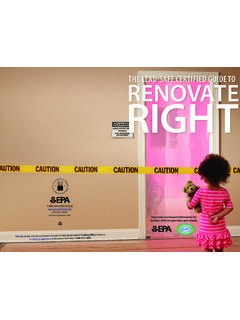Transcription of Environmental Program Fact Sheet - Connecticut
1 STATE OF Connecticut . DEPARTMENT OF ENERGY & Environmental PROTECTION. BUREAU OF MATERIALS MANAGEMENT & COMPLIANCE ASSURANCE. WASTE ENGINEERING & ENFORCEMENT DIVISION. 79 ELM STREET, HARTFORD CT 06106-5127. TEL. (860) 424-3023 TOLL-FREE: 1-888-424-4193 Environmental Program fact Sheet DISPOSAL OF BUILDING MATERIALS COATED WITH LEAD-BASED PAINT. --A fact Sheet for Homeowners and Small Contractors-- Here are some facts you should be aware of if you are preparing for a lead abatement, renovation, or demolition project which may involve lead-based paint (or LBP ): 1. WHAT IS LBP AND WHY SHOULD I BE CONCERNED?
2 Lead-based paint (or LBP ) was used in interior and exterior paints for many years. Houses and other buildings built before 1978 often have some LBP in them. Chipping, peeling or flaking LBP can expose residents to toxic levels of lead. 2. IS LBP A HAZARDOUS WASTE? Depending on the exact amount of LBP present, building materials may be classified as hazardous waste when being disposed of. 3. SHOULD I HIRE A CONTRACTOR TO DO THE WORK FOR ME? The improper removal or disposal of even relatively small amounts of LBP materials can contaminate your home or property with toxic levels of lead. As a result, DEEP recommends that homeowners consider hiring qualified contractors even for small or medium-sized removal projects.
3 Homeowners may also wish to hire a qualified specialist to do a lead survey of their home if they suspect LBP may be present. The Connecticut Health Departments Lead Program can provide assistance in this area. For more information regarding lead surveys and abatements, call (860) 509-7299. 4. CAN I REMOVE THE MATERIAL MYSELF? Homeowners may remove and dispose of LBP materials themselves, as long as: the job is minor in nature (such as replacing windows, siding, or doors);. the amount of material removed does not exceed 10 cubic yards (roughly the amount that would fill a large trash dumpster).
4 The job does not involve demolition of the whole building or a major portion of it; and the waste is placed in your normal trash container, or taken to a permitted disposal facility, such as a transfer station or bulky waste landfill. Be sure to check with the hauler or facility operator ahead of time to see if more strict local rules apply. Chemical wastes such as paint stripping wastes should not be disposed of in the trash, but should be taken to a local household hazardous waste collection day. Revised 4/20/2017. Page 2 of 2. If the removal project does not fall within these limits, the homeowner should hire a qualified contractor to remove and dispose of the waste.
5 See paragraphs 5, 6, and 7 below regarding the rules for contractors doing LBP removal work. 5. WHAT RULES MUST CONTRACTORS FOLLOW? Unlike homeowners, contractors conducting lead abatement, renovation, or demolition projects involving LBP must comply with all applicable waste management regulations for any wastes that they manage for their customers. This would include complying with hazardous waste regulations, if the material contains enough LBP to be defined as hazardous waste. 6. HOW DO YOU DETERMINE IF LBP WASTE IS A HAZARDOUS WASTE? The standard method for determining if LBP waste is hazardous or not is a laboratory test called the Toxicity Characteristic Leaching Procedure, or TCLP test.
6 There are numerous private laboratories throughout Connecticut that can perform this test. However, obtaining accurate samples of LBP waste can be difficult, and there are also other DEEP-approved methods for determining if LBP waste is hazardous. If you have any questions about testing LBP waste, call DEEP at one of the numbers listed below, or request the guidance manual described in the following paragraph, for assistance in testing your waste. 7. HAS DEEP DEVELOPED WRITTEN GUIDANCE? DEEP has developed a guidance manual for contractors and other technical personnel that describes in great detail how to properly test, characterize, and dispose of LBP wastes.
7 The manual also describes the storage and transportation requirements that would apply to contractors who may be generating hazardous waste as a result of the lead abatement, renovation, or demolition work they are doing. The manual is entitled Guidance for the Management and Disposal of Lead-Contaminated Materials Generated in the Lead Abatement, Renovation, and Demolition Industries. Copies of the manual may be obtained by writing or calling DEEP. Addresses and phone numbers are listed below: Written requests: State of Connecticut DEEP. Bureau of Materials Management & Compliance Assurance Waste Engineering & Enforcement Division 79 Elm Street Hartford, CT 06106-5127.
8 Phone requests: (860) 424-3023. OR TOLL FREE AT 1-888-424-4193. 8. WHO CAN I CALL IF I HAVE QUESTIONS? If you have any questions about LBP waste, you may call DEEP at one of the numbers listed above. Our business hours are between 8:30 and 4:30 , Monday through Friday, except State Holidays. The Department of Environmental Protection is an equal opportunity/affirmative action employer, and its programs and services are offered without regard to race, color, religion, national origin, age, sex, or disability. In conformance with the Americans with Disabilities Act, the DEEP makes every effort to provide equally effective services for persons with disabilities.
9 Individuals with disabilities needing auxiliary aids or services for effective communication should call (860) 424- 3035 or TDD (860) 424-3333. Revised 4/20/2017.

















